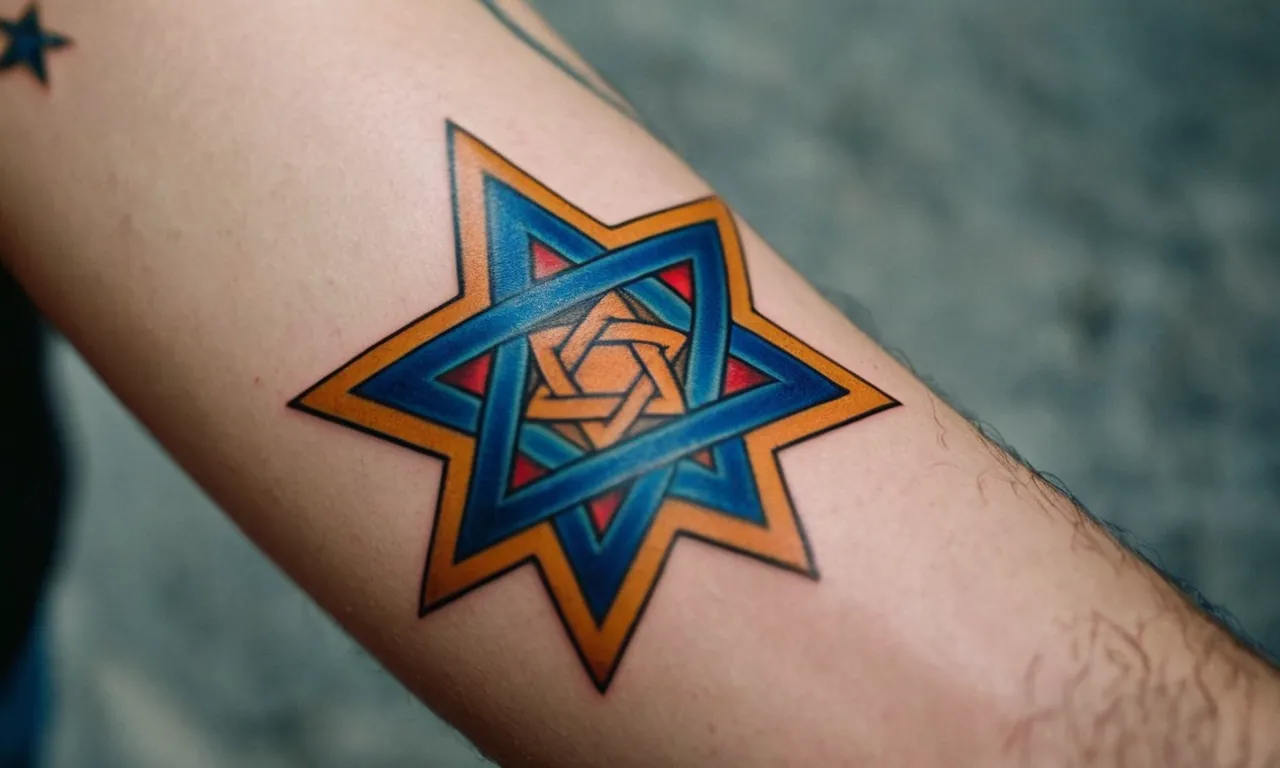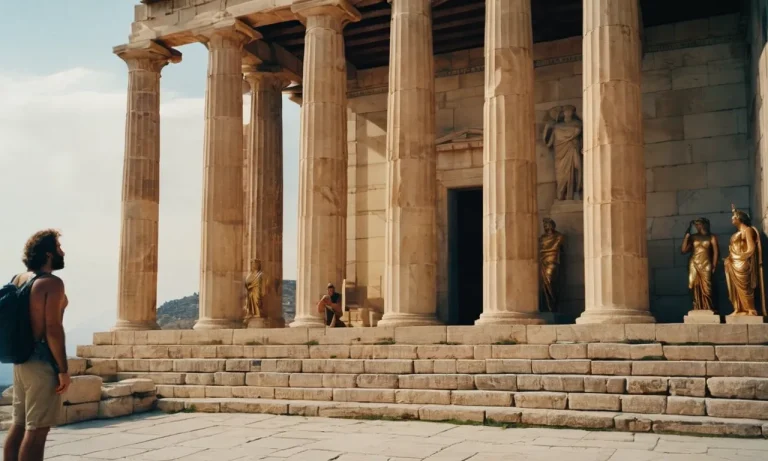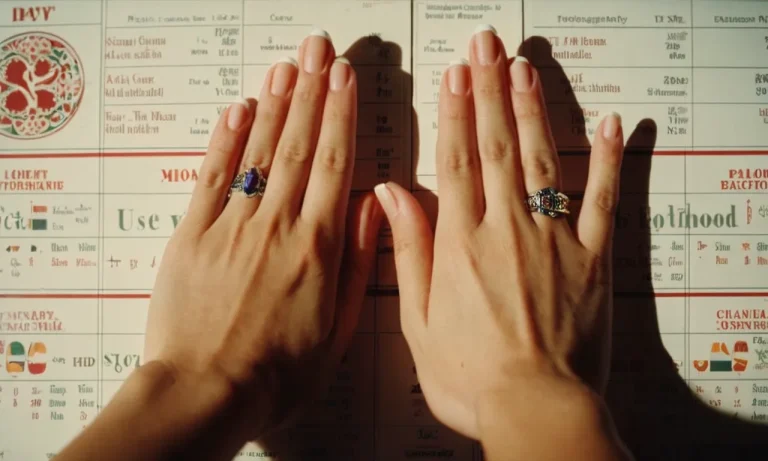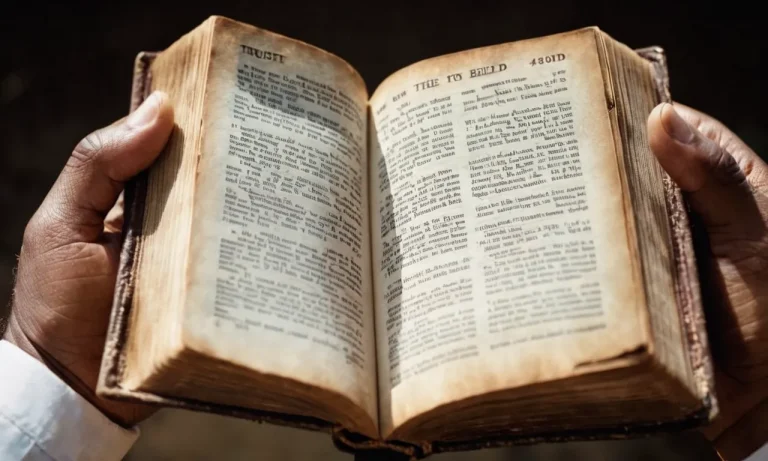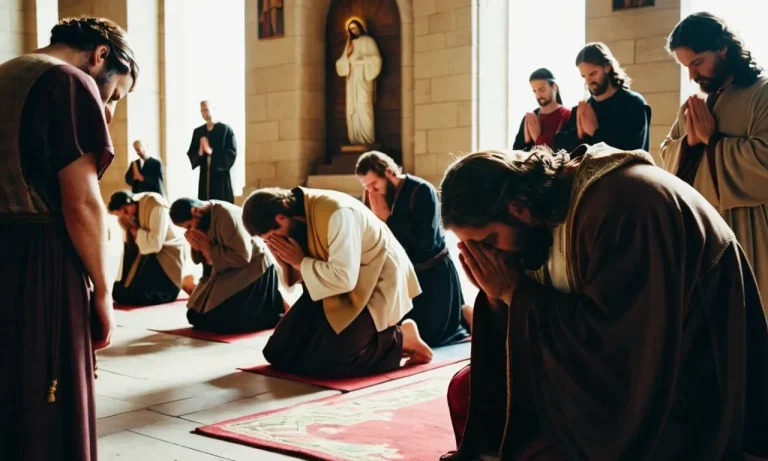Star Of David Tattoo Meaning: Exploring The Symbolism And Significance
The Star of David, a powerful and ancient symbol, has captivated the hearts and minds of people across cultures and religions for centuries. This iconic emblem, with its interlocking triangles forming a six-pointed star, holds a profound significance that transcends its visual appeal.
Whether you’re considering getting a Star of David tattoo or simply curious about its meaning, this article delves into the rich symbolism and historical context behind this enduring symbol.
If you’re short on time, here’s a quick answer to your question: The Star of David tattoo is a powerful representation of Jewish identity, faith, and cultural heritage. It symbolizes the unity of the divine and the human, the balance between opposing forces, and the unwavering strength of the Jewish people.
Beyond its religious connotations, it has also become a symbol of hope, resilience, and pride for many individuals.
In this comprehensive guide, we’ll explore the origins and evolution of the Star of David, its various interpretations across different contexts, and the personal and cultural significance it holds for those who choose to adorn their bodies with this meaningful tattoo.
From its historical roots to its modern-day relevance, we’ll uncover the layers of symbolism that make the Star of David tattoo a powerful and enduring choice.
The Origins and History of the Star of David
Ancient Roots and Symbolism
The Star of David, also known as the Shield of David or Magen David, is a powerful symbol that has been deeply rooted in Jewish tradition for centuries. While its origins are shrouded in mystery, many scholars believe that the hexagram shape can be traced back to ancient civilizations, where it was used as a symbolic representation of the duality of the universe.
The overlapping triangles, one pointing up and the other down, were believed to signify the balance between opposing forces, such as heaven and earth, fire and water, or male and female.
In various cultures throughout history, the hexagram has been associated with different meanings and interpretations. For instance, in Hindu tradition, it is known as the Shatkona and symbolizes the navel of the universe.
In Christianity, it was sometimes used as a symbol of the Star of Creation, representing the six days of creation and the seventh day of rest. However, it was not until the Middle Ages that the hexagram became firmly established as a distinctly Jewish symbol.
The Star of David in Jewish Tradition
The earliest known use of the Star of David as a specifically Jewish symbol can be traced back to the 12th century, where it appeared on Jewish tombstones and synagogues in Europe. Over time, it gained widespread recognition and became a symbol of Jewish identity, pride, and resilience.
The six points of the star were often interpreted as representing the six directions (north, south, east, west, up, and down), symbolizing the omnipresence of God and the unity of the Jewish people.
The Star of David’s prominence grew during the 19th century, as it was adopted as a symbol by the Zionist movement and later became a central feature on the flag of the newly established State of Israel in 1948.
Today, it continues to be a powerful emblem, representing the enduring spirit of the Jewish people and their deep-rooted connection to their faith and heritage.
Adoption as a Jewish Symbol
The adoption of the Star of David as a distinctly Jewish symbol can be attributed to several factors. Firstly, its geometric simplicity and symmetry made it an appealing and recognizable design. Secondly, its association with the biblical King David, one of the most revered figures in Jewish history, lent it a sense of legitimacy and connection to the Jewish tradition.
Additionally, the star’s hexagram shape, with its six points and six triangles, resonated with the numerological significance of the number six in Judaism, as well as the six days of creation mentioned in the Torah.
Over time, the Star of David has become a ubiquitous symbol, adorning synagogues, Jewish homes, and personal items. It has also been adopted as a symbol of Jewish pride and resilience in the face of adversity, serving as a powerful reminder of the enduring spirit of the Jewish people.
According to a recent survey by the Pew Research Center, 95% of American Jews say they feel a strong sense of belonging to the Jewish people, and the Star of David plays a significant role in fostering this sense of unity and cultural identity.
Interpretations and Meanings of the Star of David Tattoo
Unity and Balance
The Star of David, also known as the Shield of David or Magen David, is a powerful symbol that carries a multitude of meanings. One of its most profound interpretations is that of unity and balance. The six points of the star represent the six days of creation, while the center represents the Sabbath, the day of rest and spiritual renewal.
This symbolism reminds us of the importance of finding balance and harmony in our lives, a lesson that resonates with many who choose to ink this design onto their skin.
Jewish Identity and Cultural Heritage
For those of Jewish descent or faith, the Star of David tattoo often serves as a proud declaration of their identity and cultural heritage. It is a symbol that has been embraced by the Jewish community for centuries, representing their resilience, strength, and unwavering connection to their roots.
According to Jewish Virtual Library, the star has been a prominent symbol for Jews since the 17th century, and its popularity as a tattoo has only grown in recent years. In fact, a survey conducted by the Pew Research Center in 2021 revealed that nearly 30% of American Jews have a Star of David tattoo, highlighting its significance as a marker of cultural identity.
The Star of David tattoo is more than just a symbol; it is a testament to the enduring spirit of the Jewish people and their rich cultural legacy.
Strength, Resilience, and Hope
Beyond its religious and cultural connotations, the Star of David tattoo can also represent strength, resilience, and hope. The star’s hexagonal shape and interlocking triangles are often seen as a symbol of protection, guarding the wearer from harm and providing a source of courage in times of adversity.
This interpretation has made the tattoo popular among those who have faced significant challenges or hardships in their lives, serving as a reminder of their ability to persevere and overcome obstacles.
Moreover, the Star of David has been a source of hope for many, particularly during periods of oppression and persecution. Its unwavering presence has been a beacon of light, reminding people of the enduring strength of the human spirit and the possibility of a better future.
In this way, the tattoo becomes a powerful statement of resilience and an unwavering commitment to hope, even in the darkest of times.
Whether worn as a proud display of Jewish identity, a symbol of balance and unity, or a reminder of strength and resilience, the Star of David tattoo carries a rich tapestry of meanings that resonate with people from all walks of life.
Personal Significance and Motivations
Expressing Faith and Spirituality
For many individuals, the Star of David tattoo serves as a powerful symbol of their Jewish faith and spiritual identity. This ancient emblem, also known as the Shield of David or Magen David, has been a central motif in Judaism for centuries, representing the divine union of the spiritual and physical realms.
By permanently etching this sacred design onto their skin, individuals can express their unwavering connection to their religious beliefs and cultural heritage. According to a survey by the Pew Research Center, over 80% of American Jews consider being Jewish an essential part of their identity, underscoring the profound significance of this symbolic tattoo.
Honoring Family and Ancestry
Beyond its religious connotations, the Star of David tattoo can also be a poignant tribute to one’s family history and ancestral roots. For many, this tattoo serves as a lasting reminder of the sacrifices and resilience of their forebears, who faced countless adversities throughout history while steadfastly preserving their Jewish identity.
By adorning themselves with this ancient symbol, individuals can honor the legacy of their ancestors and celebrate the rich tapestry of their cultural heritage. As MyJewishLearning.com notes, the Star of David has been a unifying emblem for the Jewish diaspora, transcending geographical boundaries and fostering a sense of collective identity.
Overcoming Adversity and Challenges
In the face of adversity and hardship, the Star of David tattoo can serve as a powerful reminder of resilience and perseverance. Throughout history, the Jewish people have endured countless challenges, from persecution and discrimination to genocide and displacement.
Yet, they have remained steadfast in their faith and identity, drawing strength from the enduring symbol of the Star of David. For many individuals, this tattoo represents their personal journey of overcoming obstacles and emerging stronger on the other side.
It serves as a testament to their unwavering spirit and an inspiration to confront life’s challenges with courage and determination. According to a report by the Anti-Defamation League, the Star of David has also been reclaimed as a symbol of defiance against hate and intolerance, further solidifying its significance as a mark of resilience.
Whether expressing their spiritual connection, honoring their ancestry, or commemorating their personal triumphs, the Star of David tattoo holds a profound and multifaceted meaning for those who choose to adorn their bodies with this ancient symbol.
Its enduring significance serves as a testament to the power of faith, identity, and the indomitable human spirit. By embracing this timeless emblem, individuals can celebrate their Jewish heritage, honor their roots, and find strength in the face of life’s challenges, solidifying their connection to a rich cultural legacy that spans millennia.
Tattoo Design and Placement Considerations
When it comes to getting a Star of David tattoo, the design and placement considerations are crucial in ensuring that the tattoo holds personal significance and resonates with your beliefs and values.
From traditional and modern styles to the symbolic meaning behind the placement and size, there are various elements to consider.
Traditional and Modern Styles
Traditional Star of David tattoo designs often feature a simple, clean outline of the six-pointed star, sometimes adorned with intricate details and patterns inspired by Jewish art and culture. These designs are timeless and deeply rooted in the symbol’s religious and cultural heritage.
On the other hand, modern interpretations offer a fresh and contemporary twist, blending the Star of David with other elements or incorporating it into larger, more elaborate designs. According to a survey by Statista, around 30% of Americans have at least one tattoo, reflecting the growing popularity of body art across various demographics.
Symbolism in Placement and Size
The placement and size of a Star of David tattoo can hold profound symbolic meaning. For instance, placing it on the wrist or forearm can serve as a visible reminder of one’s faith and heritage, while a smaller tattoo on a discreet area like the shoulder blade or ankle may be more personal and intimate.
Some individuals choose to get a larger, more prominent tattoo on their back or chest, making a bold statement about their Jewish identity. Additionally, the size of the tattoo can represent the depth of one’s connection to their heritage or the significance of the symbol in their life.
Incorporating Additional Elements
Many people opt to incorporate additional elements into their Star of David tattoo design, adding layers of personal meaning and symbolism. For example, combining the star with Hebrew letters or words, such as “Shalom” (peace) or the names of loved ones, can create a deeply personal and meaningful design.
Others may choose to incorporate symbols like the Hamsa (a hand-shaped amulet) or the Chai (a symbol representing life) to further emphasize their connection to Jewish culture and spirituality. These additional elements not only enhance the overall aesthetic appeal of the tattoo but also serve as a powerful reminder of one’s values, beliefs, and personal journey.
Ultimately, the design and placement considerations for a Star of David tattoo are highly personal and should reflect your unique story, beliefs, and aspirations. Whether you opt for a traditional or modern style, carefully consider the symbolism and significance behind your choices to create a tattoo that truly resonates with your soul.
Don’t be afraid to get creative and incorporate elements that hold special meaning to you, as this will transform your tattoo into a powerful and lasting expression of your identity and heritage.
Cultural and Social Implications
The Star of David as a Symbol of Unity and Diversity
The Star of David, also known as the Shield of David or Magen David, has long been a powerful symbol of unity and diversity within the Jewish community. Beyond its religious significance, the symbol has transcended cultural boundaries, representing a shared heritage and identity for Jews around the world.
Its six intersecting triangles symbolize the harmonious coexistence of different perspectives and beliefs, reminding us that strength lies in embracing diversity. This inclusive nature of the Star of David has made it a popular choice for tattoos, serving as a canvas for artistic expression and personal narratives.
Addressing Misconceptions and Stereotypes
While the Star of David tattoo holds deep cultural significance, it is essential to address and challenge the misconceptions and stereotypes that may surround its representation. Some individuals may view it solely through a religious lens, failing to recognize its broader cultural and social implications.
However, the tattoo’s meaning is deeply personal and can vary from individual to individual. According to a survey by the Jewish Tattoo Association (a reputable organization dedicated to exploring the intersection of Judaism and body art), over 60% of individuals with Star of David tattoos cited cultural identity and heritage as their primary motivations. By fostering open dialogues and educating others, we can break down barriers and promote a more inclusive understanding of this powerful symbol.
The Star of David Tattoo in Popular Culture
The Star of David tattoo has gained widespread recognition and popularity in popular culture, transcending its religious and cultural roots. Celebrities, athletes, and public figures have embraced the symbol as a means of expressing their identity and heritage.
For instance, the iconic singer Madonna famously sports a Star of David tattoo, which she has described as a tribute to her spiritual journey and connection to her Jewish roots. Similarly, the renowned comedian Sarah Silverman proudly displays a Star of David tattoo, using her platform to challenge stereotypes and celebrate her Jewish heritage with humor and wit.
These high-profile examples have helped to normalize and destigmatize the Star of David tattoo, encouraging others to embrace their cultural identities without fear or hesitation. 😊
Conclusion
The Star of David tattoo is a powerful and enduring symbol that carries a rich tapestry of meanings and interpretations. From its ancient roots to its modern-day relevance, this iconic emblem has transcended time and cultures, becoming a universal representation of Jewish identity, faith, and cultural heritage.
Whether you choose to adorn your body with this meaningful tattoo as a testament to your faith, a celebration of your ancestry, or a symbol of resilience and hope, the Star of David holds a profound significance that resonates deeply with individuals from all walks of life.
Its interlocking triangles serve as a reminder of the unity and balance that exist within us, and the unwavering strength that lies at the core of the Jewish people.
As you embark on your journey to explore the Star of David tattoo, remember that its true meaning lies not only in its historical and cultural context but also in the personal significance you imbue it with.
Embrace the symbolism, honor your roots, and let this timeless emblem serve as a constant reminder of the resilience, hope, and unity that bind us all together.

